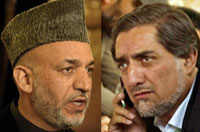Afghan presidential election - second round
Explainer: Why is it taking place and will it work?
by Tony Cross
Article published on the 2009-10-22 Latest update 2009-10-29 17:05 TU
So, why is the second vote taking place and will it bring political peace to a war-ravaged country? All you need to know ahead of the 7 November vote.
Why a second round?
There nearly was no run-off between Karzai and his principal rival, Abdullah Abdullah. The Independent Election Commission (IEC) announced hard-to-believe turnout figures almost as soon as voting was over and presented early results which showed Karzai the winner in the first round.
But the losing candidates all cried foul. Abdullah grabbed the headlines with accusations of ballot box stuffing, fake turnout figures and other malpractice. Other candidates, notably Ramazan Bashardost who came in third, claimed that not only had Karzai’s supporters indulged in intimidation and fraud - Abdullah’s had, too.
But more and more evidence of fraud emerged, especially in the south. Taliban threats and violence were reported to have frightened thousands of voters away from the polls but turnout figures seemed not to bear that out. British officials estimate that in one southern area, Babaji, 150 people voted out of a 55,000 population. Most people in the south are Pashtuns, like Karzai, and would be likely to vote for him.
What took so long?
They do not seem keen to talk about it now, but foreign observers and diplomats were slow to sound the alarm. A smooth-running poll with a clear result in the first round would have been good news for everyone – except the losing candidates and the people who voted for them.
The day after the poll, US President Barack Obama called it "an important step forward".
In the days immediately following the election, the consensus seemed to be a repeat of the judgement on the 2004 election - there had been fraud but not enough to distort the result.
After a long wait and drip-feed announcements favourable to Karzai, the IEC announced a final result of 55 per cent for the incumbent and 28 per cent for Abdullah. The ensuing uproar led to a confrontation between the IEC, often accused of being packed by pro-Karzai officials, and the Electoral Complaints Commission (ECC), which has a majority of foreign members. The ECC declared it had found “clear and convincing evidence of fraud” and ordered a large number of votes to be scrapped.
And, while the head of the UN’s mission, Kai Eide, refused to reveal evidence of low tournout in the south on the grounds that there was no proof, his deputy, Peter Galbraith, broke ranks. He revealed that officials had refused to close down 1,500 so-called “ghost polling stations”, among other charges. Galbraith was sacked but the UN eventually admitted that fraud had taken place.
That was not the end of the matter. Mid-October saw frenzied international pressure on Karzai, who was now complaining about foreign interference on the ECC. US Secretary of State Hillary Clinton, Senator John Kerry, British Prime Minister Gordon Brown and French Foreign Minister Bernard Kouchner all told him he had to back down. But they also pushed for a deal with Abdullah to form a coalition government and avoid a second round. Both men seem to have rejected that idea, Karzai the more fervently.
What are the problems?
Barring a last-minute deal, there will be a second round. But it won’t be easy.
The International Security Assistance Force (Isaf) says that it has been planning for this for some time. But the Taliban haven’t gone away and there is no reason to suppose that security will be much better.
Logistics are always a challenge in Afghanistan, with its mountainous terrain and poor infrastructure. During the August election, ballot boxes had to be delivered by helicopters, motorbikes and donkeys. Now the winter is setting in and snow will have rendered some remote areas inaccessible, even for donkeys. Officials seem resigned to some voters not being able to cast their ballots.
Will this election be fraud-free?
The UN has ordered 200 district election officials to be investigated for fraud. That is a majority, since there were 380 in total. Some or all may be replaced. It is not entirely clear where independent, honest and competent replacements are to come from. They will be sent on a one-week training course, where it is hoped they will pick up the necessary skills.
Local and international observers will also have to be found. The Afghan monitoring body, the Free and Fair Election Foundation of Afghanistan says it can find 5,000 in two weeks. That is 2,000 less than in round one.
There does not seem to be time to reform the IEC.
Who will win?
The revised final results for the first-round vote gave Karzai 49.67 per cent, so he should have it in the bag.
Or should he?
We still don’t really know how reliable that figure is, nor whether a poll without fraud, should it take place, will give anything like the same result.
The revised turnout figure for August was a low 38 per cent. It could well be lower this time round. Voters may be disoriented or disgusted by the wrangling of the last two months. Many were cynical about the effect of their vote in August. Now some are saying it didn’t count, anyway. And Karzai has complained so loudly about foreign “interference” that he may have discouraged his own voters from turning out again.
And the region where the turnout was most exaggerated in August was the south – Karzai’s Pashtun base. Accurate voting figures and Taliban threats may conspire to deprive the incumbent of thousands of votes.






